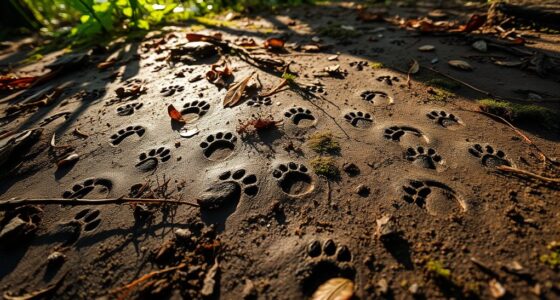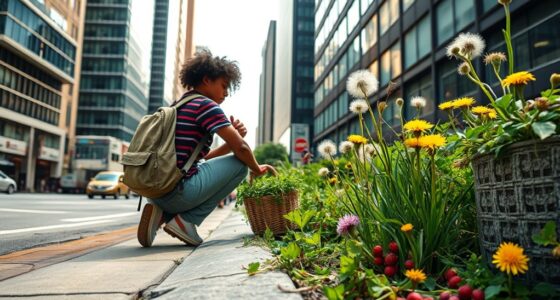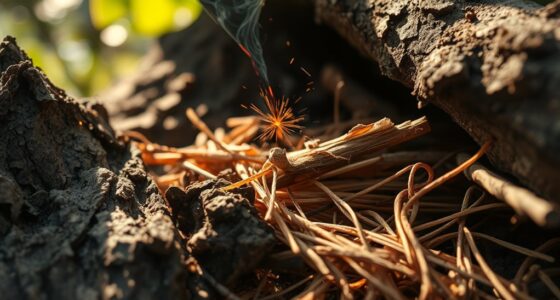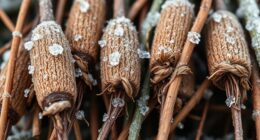Medicinal foraging can be a lifesaver if you know which plants to look for and how to use them safely. Plants like ginkgo biloba boost memory, while elderberry fights infections. Always identify plants carefully, harvest responsibly, and avoid toxins. Use seasonal guides to find the best time for collection. With proper knowledge, wild plants can treat common ailments and support your health. Keep exploring to discover more about harnessing nature’s healing power.
Key Takeaways
- Proper identification of medicinal plants ensures safety and effectiveness, avoiding toxic look-alikes.
- Harvesting wild plants responsibly prevents depletion and protects endangered species.
- Key medicinal plants like Ginkgo Biloba, turmeric, and plantain can treat common ailments and improve health.
- Seasonal foraging maximizes plant potency while reducing risks associated with misidentification.
- Using traditional knowledge and expert guidance enhances safe, life-saving application of wild medicinal plants.
Essential Medicinal Plants and Their Benefits
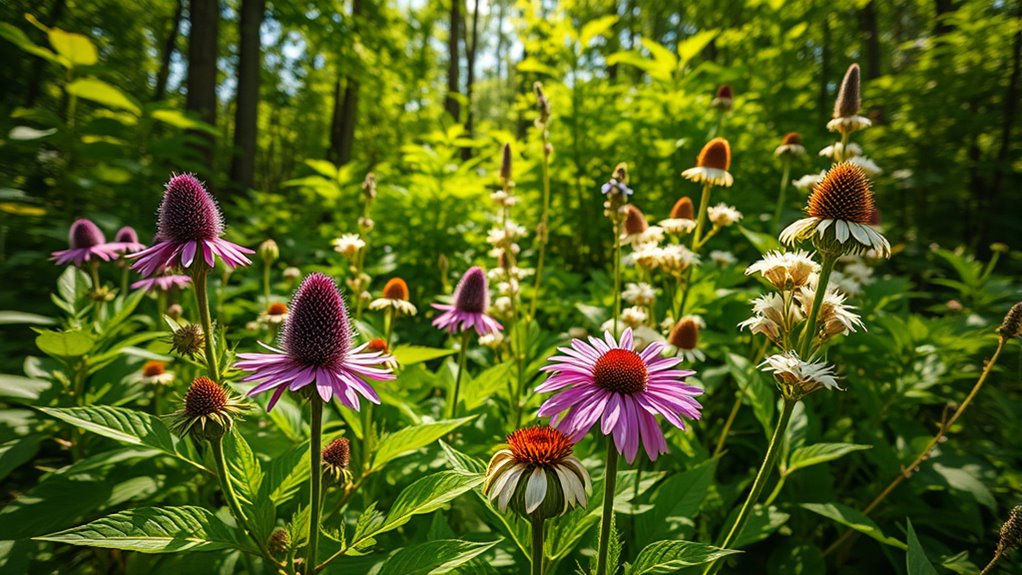
Have you ever wondered which plants can boost your health naturally? Essential medicinal plants offer powerful benefits that can support various aspects of your well-being.
Ginkgo Biloba is renowned for enhancing memory, preventing dementia, and fighting depression and anxiety.
Hyssop stimulates mucus production, soothing sore throats and coughs, while also aiding digestion.
Plantain helps alleviate cold symptoms and promotes wound healing with its anti-inflammatory and antimicrobial properties.
Turmeric contains curcumin, which reduces inflammation and fights pain.
Basil provides anti-inflammatory and antibacterial effects, and ginger helps with nausea and digestion.
These plants are versatile, naturally occurring remedies that can improve respiratory, mental, and digestive health.
Incorporating them into your routine can empower you to manage common ailments and promote overall wellness naturally.
Safe Foraging Practices to Protect Your Health

Ensuring safe foraging is essential to protect your health and preserve natural resources. First, always be certain of a plant’s identity; deadly poisonous look-alikes are common. Use reliable field guides and learn to distinguish safe plants from hazardous ones. Avoid plants that resemble toxic species, and educate yourself about local safe medicinal plants and regional poisonous varieties. Incorporating knowledge about exfoliation and skin care can also help in understanding how certain plants or substances may impact your health when used topically or ingested.
For environmental safety, forage in pollution-free areas, away from roads and industrial sites, and respect protected ecosystems and private property. Never harvest more than one-third of a plant to avoid depleting populations, and avoid endangered species. Be mindful of contamination risks from pesticides and stay aware of potential allergies.
Always handle and store plants properly, and have basic first aid knowledge in case of reactions or poisoning.
Seasonal Guide to Harvesting Wild Plants

Timing your wild plant harvests with the seasons maximizes both safety and effectiveness. In spring, look for plants like dandelion and plantain, which emerge early and are rich in medicinal properties. Incorporating a variety of regional and cultural breakfast traditions can also inspire your morning routine. Summer is ideal for harvesting elderberry and chamomile when they’re in full bloom, offering immune-boosting benefits. As fall approaches, focus on burdock root and sassafras, preparing them for future use. Winter foraging involves plants like rose hips and ginseng, which remain accessible and potent. Always identify plants accurately and harvest responsibly, taking only what you need and leaving enough behind for regrowth. Using the right vacuums for pet hair can help keep your home clean during intensive foraging seasons. Staying informed about AI advancements can also enhance your understanding of plant properties and foraging techniques. Learning about medicinal plant identification is essential to safely gather and utilize wild plants effectively. Remember to maintain a year-round plan to ensure a steady supply of medicinal plants, allowing you to benefit from nature’s pharmacy regardless of the season.
Harnessing Nature’s Pharmacy for Better Well-Being
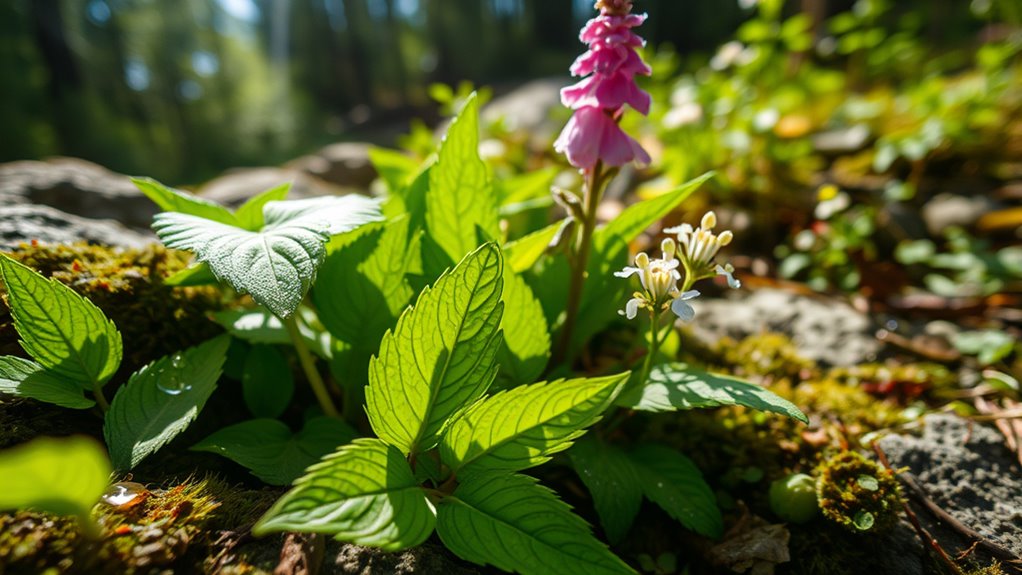
Harnessing nature’s pharmacy offers a powerful way to improve your well-being by reconnecting with traditional healing practices that have stood the test of time. Indigenous cultures have used wild plants for generations, passing down valuable knowledge that modern societies are now rediscovering. Incorporating these plants into your understanding of health encourages sustainable practices, preserves cultural traditions, and fosters a deeper connection with nature’s healing resources. Proper identification and expert guidance ensure safe and effective use of these natural remedies. For example, vetted Vetted – Flat Iron Bike options demonstrate the importance of reliable equipment when exploring outdoor medicinal plant gathering, ensuring safety and efficiency during your foraging adventures. Regularly practicing skills such as changing gears on a gravel bike can also enhance your outdoor experience, making exploration safer and more enjoyable.
Incorporating Wild Plants Into Your Daily Diet

Incorporating wild plants into your daily diet is a simple way to boost nutrition and diversify your meals. These plants often pack more nutrients than store-bought produce, helping combat malnutrition. For example, dandelion greens are rich in potassium, vitamin C, and calcium, making them a healthy addition to salads or smoothies. Wild berries from Alaska contain higher antioxidants than farmed berries, offering extra health benefits. Eating a variety of wild plants supports your gut health by providing diverse antioxidants. Plus, they reflect cultural traditions, enhance food diversity, and serve as affordable options in food deserts. To safely enjoy wild plants, ensure correct identification and proper preparation. Understanding foraging range and seasonal availability can help you harvest sustainably and responsibly. Additionally, knowing harvesting techniques can improve your foraging success and safety. Staying informed about AI safety measures can help ensure the responsible development of foraging technologies. Incorporating these plants can introduce new flavors while promoting sustainability and environmental awareness. Being aware of cookie and privacy policies ensures that your online activities related to foraging research are protected and respect your privacy. Exploring local regulations can also help you forage legally and ethically in your area.
Frequently Asked Questions
How Do I Differentiate Between Edible and Toxic Wild Plants?
To tell apart edible from toxic wild plants, start by observing key traits. Look for distinctive features like leaf shapes, fruits, and flowers, and note if the plant has milky sap or shiny leaves, which can indicate toxicity.
Use guidebooks, apps, or consult experts for accurate identification. Always be cautious—avoid plants with warning signs and test new plants carefully before consumption.
When in doubt, it’s safer to leave it.
What Legal Restrictions Exist Around Foraging in Public Lands?
You need to know that foraging on public lands comes with specific legal restrictions. You’ll generally need permits for certain activities, like harvesting in national forests, and must avoid prohibited areas such as national parks and city parks unless you get explicit permission.
Fines can be hefty, and overharvesting or damaging ecosystems could land you in trouble. Always check local regulations and obtain necessary permissions before foraging to stay within the law.
Can Foraging Wild Plants Replace Conventional Medicine?
You might wonder if foraging wild plants can replace conventional medicine. While herbs offer immediate, local, and cost-effective health solutions, they can’t fully replace modern treatments yet.
Effective integration requires rigorous testing and regulation. You should be cautious, as untested remedies could pose risks.
With advancements in technology, combining traditional knowledge with scientific validation can improve safety and efficacy, making foraged plants a valuable complementary option, not a complete substitute.
How Do I Ensure Sustainable Harvesting Without Damaging Ecosystems?
Imagine you’re in a lush forest, carefully selecting plants, but how can you do so without harming the fragile balance around you? You can guarantee sustainable harvesting by only taking from abundant populations, respecting land access and regulations, and avoiding rare species.
Monitor plant health, harvest responsibly, and give back to the ecosystem. Your mindful approach keeps the environment thriving while you gather what’s needed, preserving nature’s gift for future generations.
What Are Common Signs of Poisoning From Mistaken Plant Identification?
When you mistake a plant for a safe one, watch for skin irritation like redness, itching, or blistering, especially within 24-48 hours. You might notice swelling, burning sensations, or linear rashes.
If ingested, symptoms include nausea, vomiting, diarrhea, or abdominal pain. Respiratory issues, dizziness, confusion, or neurological signs like tremors can also occur.
Delayed reactions make early identification tricky, so always double-check plant IDs to avoid poisoning.
Conclusion
Think of wild plants as hidden treasures in your personal treasure chest, each holding the key to your health and vigor. By learning to recognize and harvest these natural gems safely, you become a skilled explorer in your own backyard. Embrace the journey of medicinal foraging, and you’ll find that nature’s pharmacy is always within reach, ready to support your well-being. Trust your instincts, stay curious, and let the wilds be your guide to better health.



